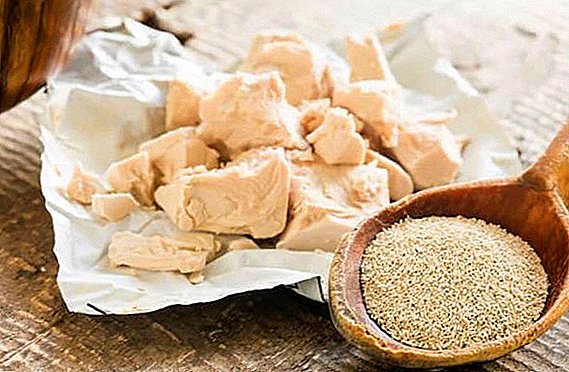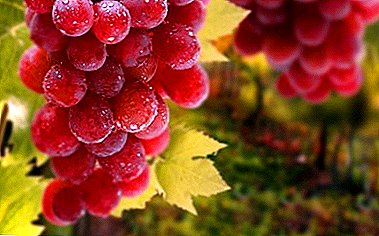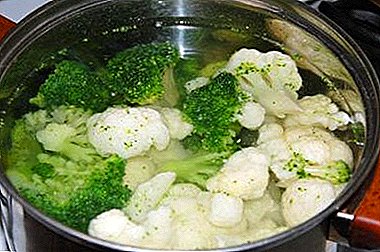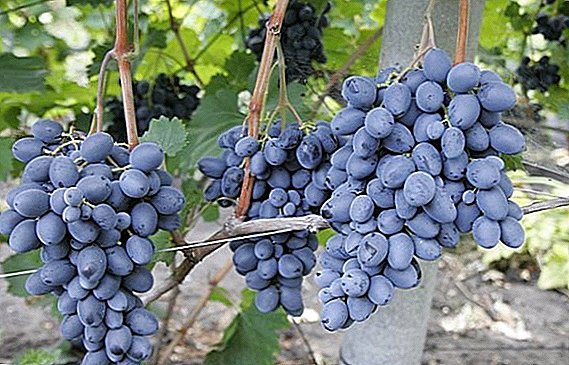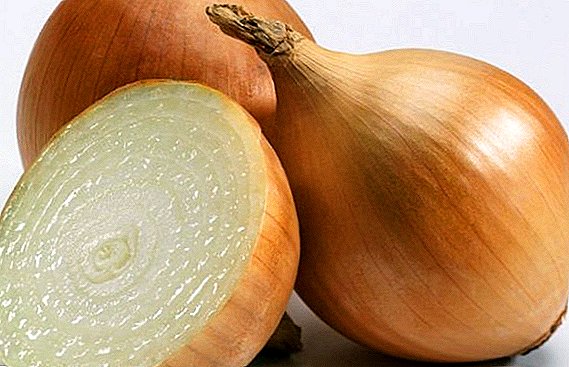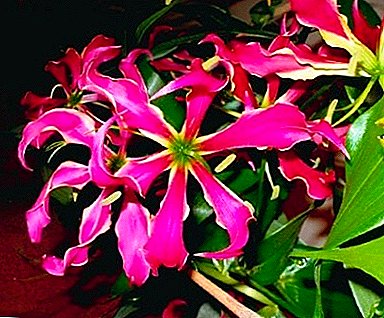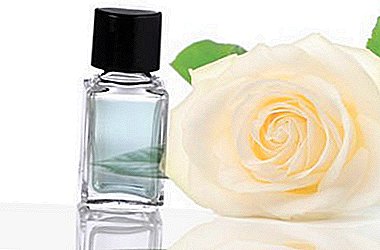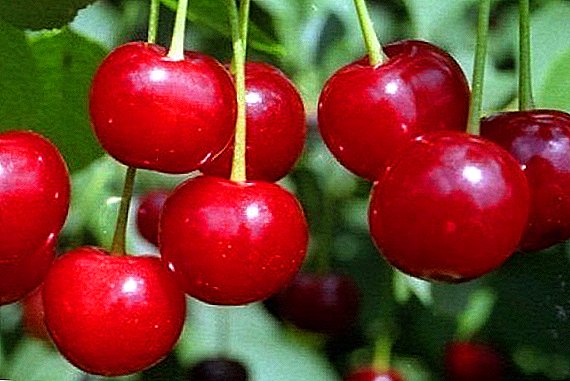
When choosing varieties of cherry for planting gardeners take into account many qualities. This and ease of planting, unpretentious care, high yields, no problems with pests and all sorts of diseases.
Generous Cherry is best suited to these selection criteria, which will become clear after reading its description.
Variety description
The description of a generous cherry variety is somewhat different from the description of its congeners.
Variety refers to the type of bushy trees, reaching a height of 2 m, round shape and medium foliage. 
Sprouts bush sprawling, with the upper direction of growth. During the growing season on the shoots cone-shaped buds up to 4 mm in size are formed, with a slight deviation from it. Kidneys are resistant to low temperatures.
You may also be interested in such varieties of cherries as: "Miracle Cherry", "Mayak", "Izobilnaya", "Morozovka", "Ural Ruby", "Lyubskaya", "Zhukovskaya", "Turgenevka".Flowering occurs at the end of May in inflorescences, each with 3-4 white flowers. The flowers are medium, with a free arrangement of cupped petals. The flowers have a high level of selfing.
The leaves are elongated dark green with serrated edges and a wedge-shaped base. The surface of the leaves is glossy. Deciduous petioles 1.2 cm long, 1 mm wide.
The yield of the bush on average is 15 kg.
Did you know? This winter cherry variety can withstand temperatures down to -35 ° C.
Breeding history
The generous cherry variety is bred by selecting from ideal free-pollinated annual seedlings of the Ideal variety at the Sverdlovsk horticulture breeding station. 
The variety is registered in the State Register of Breeding Achievements of the Russian Federation in 1958.
Founders of the variety - N.I. Gvozdyukova and Zhukov S.V.
Characteristics and features of the fruit
The fruits of this variety ripen late and uneven. Harvest time comes at the end of August and the beginning of September. The berries are kept on a long and thin stalk, so they do not crumble for a long time. 
Weight: 3-4 years
Colour: Dark red.
The form: rounded, in the center of the top is a small funnel.
Taste: sweet and sour.
Pulp: medium density, watery.
Stone: large, easily separated from the pulp.
Important! Thanks to the dense pulp, the berries tolerate transportation over long distances.
Landing
Land for planting is better to choose on a hill, without close to the groundwater. Wet soil does not contribute to the normal development of the cherry in this class. The best is the sunny side of the site.
Did you know? In order to increase the yield, the landing of the generous Variety is made in the vicinity of such varieties of cherries: Maksimovskaya, Subbotinskaya, Polevka.
 Soil for landing prepares in advance. In late autumn or early spring (at least 2 weeks before planting), the soil is dug up, fertilizer is applied. The amount of fertilizer is calculated in the ratio of 40-60 g of superphosphates, 20-30 g of potassium salt and 10-15 kg of humus per 1 square meter.
Soil for landing prepares in advance. In late autumn or early spring (at least 2 weeks before planting), the soil is dug up, fertilizer is applied. The amount of fertilizer is calculated in the ratio of 40-60 g of superphosphates, 20-30 g of potassium salt and 10-15 kg of humus per 1 square meter.If the soil is acidic, then 100 g of lime can be applied to each square meter.
Planting requires a healthy and strong planting material. Saplings can be bought in the garden markets, and you can grow yourself.
Methods of growing planting material:
Sowing campaign.
For this method, an important step is the selection of seeds (seed) for subsequent planting. Seeds are taken from healthy and ripe berries, without signs of disease or deterioration.
Seed preparation does not imply any special exposure before planting. The extracted seeds can be kept in any container without a substrate or placed in a wet mixture of sawdust, sand and moss.
Before planting, seeds should be prepared by soaking them in water for 7 days.
Important! With such seed preparation, daily water changes are required.
The time of planting seeds can come both in the spring season and in the autumn. 
Autumn time for planting involves the passage of a certain stage of rest before germination for seeds. The winter period contributes to this stage and will help harden the seeds. But weather conditions are not always favorable, especially in the northern areas.
The most optimal and reliable method is planting seeds in the spring. A good spring germination will contribute to good seed germination (long aging of seeds to accelerate germination).
The stratification stage takes a period of 150-180 days and consists of the following stages:
- at the initial stage, seeds are disinfected for at least 10 minutes in a weak (pink) solution of potassium permanganate;
- then seeds are placed for germination in a mixture of sawdust, washed river sand or sphagnum moss. Contain such planting material at a temperature of 15 ° C to 20 ° C;
- at the first manifestations of germination (cracking of seeds), the container is placed in a cold room (or refrigerator) with air temperature from 2 ° C to 6 ° C;
- when the third part of the seed germinates, they are obliged to harden. To do this, a container with planting material can be brought outside (as a rule, this stage of stratification falls on the end of winter), if the weather is stable without large fluctuations in temperature. You can also harden the seeds in the rooms (cellars) by placing the seeds on ice or snow.
Important! Before each stage of stratification, the seed mixture needs to be moistened and mix for additional air access.
Germinated and hardened seeds are planted in an open and prepared soil in the spring, when weather conditions have already been established and cold returns are not expected. In the selected area, grooves are made up to a depth of 5 cm. The distance between the grooves is at least 30 cm. Seeds are first released from the substrate and laid out into the grooves at a distance of 5 cm from each other. Placed seeds sprinkled with earth, moistened and covered with a layer of sawdust, straw or hay (mulch). 
To grow a cherry from a stone is quite a laborious process that requires attention and physical costs. There is the most simple and optimal way to grow a cherry tree - cutting the root system or planting your own seedlings.
Kornosobstvenny planting material (shoots, root cuttings).
Often a tree gives rise to a branch in the periphery of the crown. Such growth is dug with a part of the root system, retreating from the trunk at least 20 cm, and transplanted to a permanent place.
The transplant time is early autumn or spring (before the appearance of buds).
If the development of this overgrowth is weak, then it is better to grow it at home for the winter season. Soil for such "rearing" should be fertilized, loose with constant moisture.
The cutting process takes place by cutting the roots. For this, the upper roots are exposed and the stalks are 15 cm long and 0.5-1.5 cm wide. The sections are inclined.
The time of harvesting root cuttings should also fall in late autumn or early spring (before the appearance of buds). For the winter season, such planting material is placed in a container with wet washed river sand and stored at 0 ° C.
The cuttings are planted in open ground in early spring in the prepared wells at a distance of at least 10 cm from each other. Put the cuttings in the hole obliquely, always cut down. The upper part of such a spine should be covered with soil at least 1 cm, the depth of the lower part should be at least 3-5 cm. 
When the seedlings form 3-4 branching roots, and visually they look healthy and stronger, they are transplanted to a permanent, pre-prepared place. During transplantation, the root system is slightly trimmed and moistened (if the roots are dry) by placing in water for 6-10 hours.
Planting in the autumn allows the seedling to take root, but the risk of frosting in the snowless winter period remains. The best results are obtained by spring planting. As soon as the soil thaws from the snow and dries a little - you can start planting.
The technology of planting seedlings involves the following actions:
- a planting pit is dug in compliance with layers of soil: the upper and lower layers of soil are divided into separate piles;
- the dimensions of the pit are observed: up to a depth of 80 cm, width up to 60 cm;
- a peg is set in the center of the pit (to support verticality), which is dusted with the top layer of excavated soil mixed with humus;
- a sapling is placed in the landing pit, the roots are straightened on the formed mound and sprinkled with the remaining earth;
Important! The root neck should be level with the soil.
- the landing site is well spilled with water and is mulched on top of humus or sawdust;
- the seedling is tied up with a "figure of eight" (so that the waist is not formed on the trunk) to the peg.
The first full fruiting of such seedlings occurs for 3-4 years. 
Care
Throughout life, a cherry tree goes through the following main stages: development (growth), fruiting and drying out.
Care at any of these stages consists in simple actions - timely watering, correct pruning of trees and protection / prevention from diseases. Such care significantly prolongs the period of active fruiting.
Did you know? Proper care of the grade guarantees a long life of the bush up to 35 years with a maximum annual fruiting for 25-30 years.
Watering
Regular watering will contribute to good development (especially for young seedlings). In the summer, especially on hot days, the passage is carried out in an amount of not less than 5 buckets of water. 
To preserve moisture after each irrigation it is possible to mulch the earth around the trunk.
Important! During fruiting should be abundant watering.
Mature and actively fruiting trees in the cool summer season is enough 3-times watering per year.
The first watering is done immediately after the flowering period. Subsequent watering -in ripening berries. The final watering is done in autumn, in advance of cold snaps.
Top dressing
Abundant fruiting cherries depends on the amount of nutrients consumed by the tree during its development. Fertilizers are applied annually to support it.
In early spring, before the growing season, nitrogen fertilizers (ammonium nitrate) are applied at the rate of one tablespoon per bucket of water. For a young tree, one bucket of such a solution is sufficient, and for an adult it is necessary to deposit 2-3 buckets of solution. 
Also organic is used as fertilizer (cow or pig manure). Such fertilizers are applied as composts prepared in the ratio of manure and water 1:10. Chicken manure is also suitable for this purpose in relation to water 1:20.
In the autumn, it is better to feed with potassium sulfate in the amount of 50 mg or superphosphate in the amount of 100 g per square meter.
When feeding and tillage, it is necessary to take into account that the root system is branched and grows at a depth of 20-40 cm. It is necessary to carry out any actions carefully in order not to damage the roots. The root system grows around the periphery of the crown.
Pruning
In bushy cherries, fruiting depends on the growth of the branches of the last year. Lack of or incorrect agrotechnology is the cause of weak growth of branches. 
At a different period of cherry development, 3 types of pruning are assumed:
- Forming - produced on young trees for the correct formation of the crown. To do this, all the lower side shoots are cut. Young seedlings side shoots are cut at a height of 60 cm from the soil level, while leaving 10-12 core;
- Sanitary - produced annually in the autumn or early spring, in advance of bud break. When pruning removed all broken, diseased or weak branches. With a thick crown, pruning is also used for thinning;
- rejuvenating - it is produced every 5-8 years, during which auxiliary shoots are cut off on the branches, thus shifting the focus of growth to the main branch.

Did you know? Fruits are formed at the ends of branches. Growth and group buds are not laid on too short fruit branches, which subsequently leads to a weak harvest of berries.
Diseases and pests
Cherries are generous resistant to diseases and pests, but unfavorable wet weather conditions cause diseases and pests.
Diseases such as coccomycosis, monilioz and klyasterosporiosis (perforated spot) are most harmful to the cherry tree.
Kokkomikoz - a disease triggered by marsupial fungus. The disease manifests itself by the appearance on the upper part of the foliage of small red spots, which subsequently merge into large ones. In addition to the leaves, berries are also affected.
Moniliasis - a fungal disease provoked by a marsupial fungus, occurs through damage in the cortex. Manifestations of the disease - the leaves turn brown, fade and subsequently dry out. Fruits are also affected by the fungus. Symptoms are darkening and blackening of the fruit with an alcoholic flavor.
Klesterosporiosis is a fungal disease, accompanied by the presence of dark brown spots on the leaves, in the place of which holes are subsequently formed as a result of the dying of leaf tissue. 
The fight against these diseases lies in such actions:
- in the removal and burning of damaged berries, leaves and branches;
- thoroughly weeding the soil near the tree;
- in the processing of the bush contact and systemic fungicides ("Strobe", "Topaz", "Horus").
Cherry fly - an insect that lays eggs in the fruit. When the larvae eat, the flesh is eaten, as a result of which such manifestations on the fruits become visible: pits and black specks.
Cherry aphid - its larvae suck sap from the leaves, as a result of which they deform, turn black and dry.
Cherry slimy sawfly is an insect that feeds on the flesh of the leaves, scraping off the upper leaf tissues, causing the leaves to dry out. 
Pest control consists in processing wood with special preparations - insecticides ("Karbofos", "Fufanon", "Iskra M"). The use of the drug is described in detail in the instructions for use.
Did you know? Cherry aphid - power source for cherry flies. Getting rid of a cherry aphid, the cherry fly is also destroyed at the same time.
Disease prevention and timely protection against pests consist in the following actions:
- Fallen leaves or mulch residues are an excellent breeding ground for bacteria and microorganisms. Therefore, timely harvested foliage and residues of mulch will prevent the occurrence of diseases;
- regular and timely whitening with lime or chalky solution of the trunk and lower branches will prevent the occurrence of diseases and prevent the moss from overgrowing the bark;
- cuts on wood should be treated with antiseptics (iron 10% or copper 5% vitriol, oil paint) or garden pitch;
- in winter, the tree trunk should be isolated from rodents by coniferous branches, paper or roofing felt.
Cherry variety Generous especially valued gardeners. It is a universal variety that does not require complex agrotechnical methods in its care. It is highly resistant to low temperatures and drought, while stable fruiting and yields are kept at a constant medium-high level. 
Easy planting of cherries, which do not require special skills, and unpretentious care attracts even generous gardeners to the Generous variety. Moreover, this variety is not particularly susceptible to diseases and pests, which has a positive effect on its plozhonoshenii.


